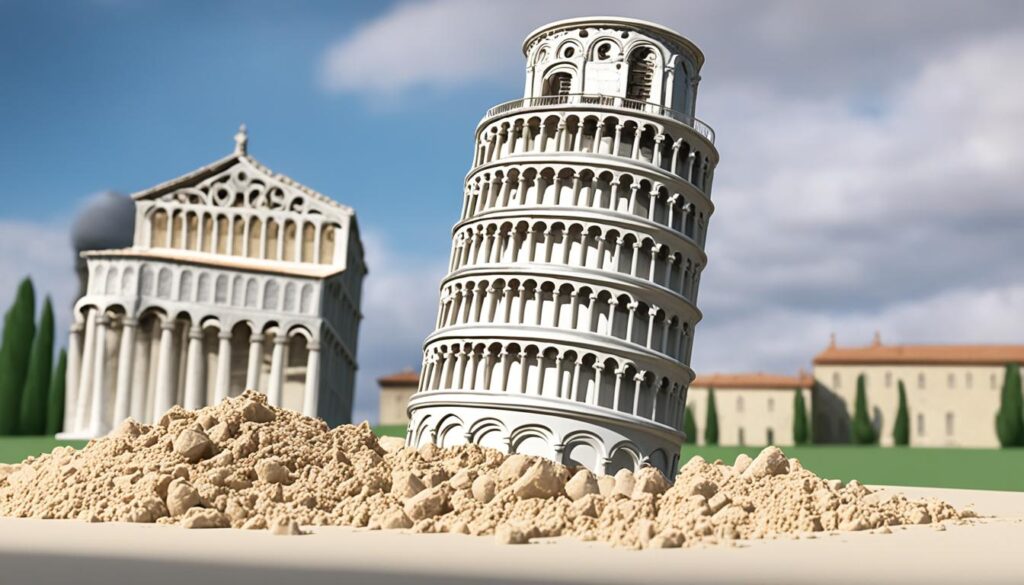The iconic landmark known as the Leaning Tower of Pisa has captivated visitors for centuries with its distinctive tilt. What many people may not realize is that this tilt was present from the very beginning of the tower’s construction in 1173. The freestanding marble bell tower, or campanile, was built as part of the cathedral complex in Pisa, Italy.
By the time builders had completed the third of the planned eight stories about five years into the project, the tower’s unstable foundation had already begun to settle unevenly. The dense mixture of clay, sand, and shells beneath the structure could not provide adequate support, causing the tower to visibly lean toward the south. This Pisa Tower’s initial tilt would only become more pronounced as construction progressed over the following decades.
Despite the evident lean, builders forged ahead with the ambitious project, ultimately creating one of the most recognizable structures in the world. The Leaning Tower of Pisa stands as a testament to the determination and ingenuity of its creators, who refused to abandon their vision in the face of a significant engineering challenge.
Key Takeaways
- The Leaning Tower of Pisa began tilting during its early construction stages due to an unstable foundation.
- The tower’s lean was evident by the time the third story was completed, about five years into the project.
- Builders continued construction despite the visible tilt, ultimately creating an iconic landmark.
- The tower’s foundation rests on a dense mixture of clay, sand, and shells that could not provide adequate support.
- The Leaning Tower of Pisa is a testament to the determination and ingenuity of its creators.
Geographical Location and Soil Composition
The Leaning Tower of Pisa, one of the most iconic structures in the world, is located in the small town of Pisa, Italy. The town sits entirely on alluvial soil, which is composed mainly of sand, clay, and shells. This unique soil composition plays a significant role in the tower’s famous tilt.
Alluvial soil is known for its softness and inability to support heavy loads, making it an unsuitable foundation for tall, hefty structures. The Tower of Pisa’s construction began in 1173, and it became evident almost immediately that there was a problem with the sinking foundation due to the soft soil. As the tower grew taller, the weight of the structure caused it to lean, as the ground beneath it was unable to provide stable support.

Interestingly, the Leaning Tower of Pisa is not the only structure in the town affected by the alluvial soil. Two other towers in Pisa, the bell tower of San Michele degli Scalzi and the bell tower of San Nicola, also started to lean after construction due to the same soil conditions. This phenomenon highlights the challenges architects and engineers face when building on soft, unstable ground.
The soil composition in Pisa has been studied extensively, and efforts have been made to stabilize the tower’s foundation. However, the alluvial soil, with its combination of sand, clay, and shells, remains a critical factor in the tower’s ongoing tilt. Despite the challenges posed by the soft soil, the Leaning Tower of Pisa has become a symbol of architectural resilience and a testament to the ingenuity of its builders, who managed to create a lasting masterpiece on a less-than-ideal foundation. To learn more about America’s independence and its connection to historical events, visit History and Mystery.
Engineering Efforts to Compensate for the Tilt
After a century-long halt in construction due to war, work resumed on the Tower of Pisa under the direction of chief engineer Giovanni di Simone. In an attempt to compensate for the lean, di Simone added extra masonry to the tower’s short side. However, this additional weight actually caused the structure to tilt even further. The tower’s unique banana shape is a direct result of this engineering effort to alter the geometry and straighten out the unplanned inclination.
Over the centuries, various attempts were made to stabilize the tower with reinforcements, but the structure continued to subside at a rate of approximately 0.05 inches per year. By 1990, the tilt had reached a precarious 5.5 degrees, putting the tower in increasing danger of collapse. Extensive stabilization work was undertaken between 1993 and 2001 to secure the tower’s future. This included carefully siphoning earth from beneath the raised end and adding counterweights to balance the lean.
Thanks to these modern engineering interventions, the tower’s tilt was successfully reduced to 3.97 degrees, a much safer inclination. The sophisticated stabilization techniques applied have strengthened the tower’s foundation against further subsidence. Engineers now believe the Leaning Tower of Pisa is secure and should remain stable for at least another 200 years, barring any unforeseen circumstances or seismic events. Preserving this iconic symbol of faulty engineering turned historic treasure will continue to require regular maintenance and monitoring.

Leave a Reply